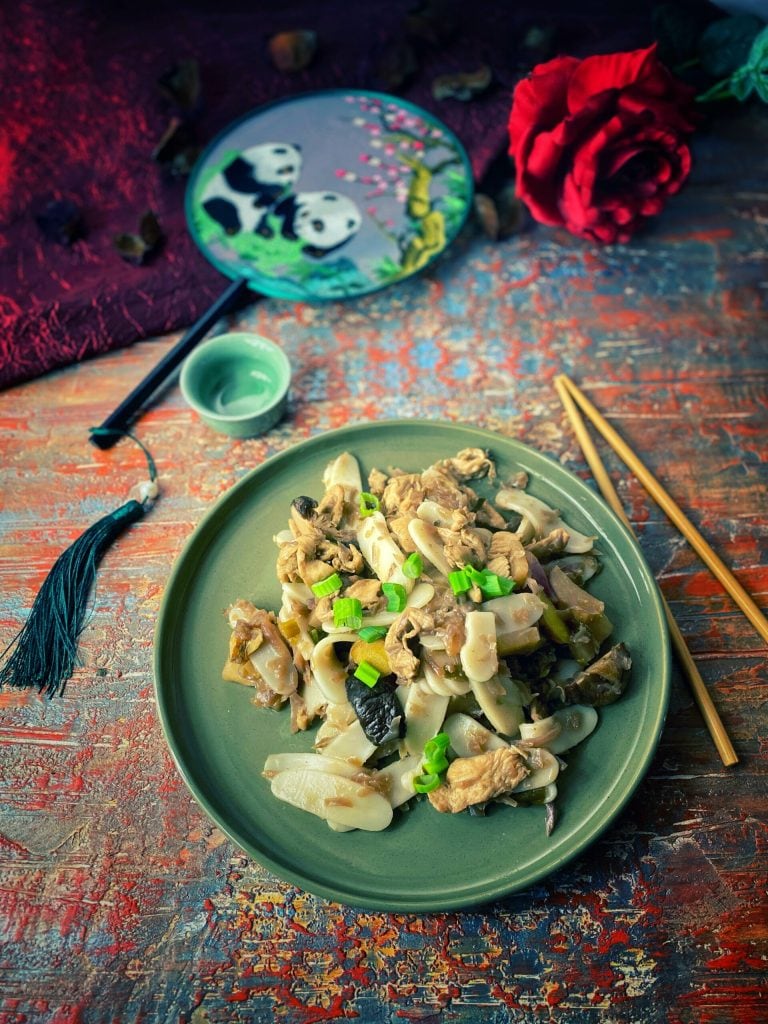The chǎo nián gāo 炒年糕 are stir-fried rice cakes typical of Shanghai.
The Shanghai nian gao is better known as rice gnocchi, not to be confused with the Nian gao – New Year’s rice cake.
The Shanghai version is made with non-glutinous rice and remains white; this characteristic is considered distinctive.
The rice gnocchi are stir-fried with qing cai, green Chinese cabbage, and a sweet-salty sauce made from soy sauce and sugar.
The most common method of cooking nian gao is to stir-fry it, after which the name of the dish changes to chǎo nián gāo (炒年糕), from chǎo meaning “stir-fried”.
There are three different types of chǎo nián gāo: the first – whose recipe follows – is a very flavorful dish, with various types of meat (beef, pork, or chicken) and vegetables (cabbage or celery).
The second dish is a sweet version, sweetened with classic white sugar, while the last version is tasteless, often consumed for its pleasant chewy texture.
Chinese Nian gao have a sticky and chewy texture.
The history of its origins might date back to 2,500 years ago in Suzhou during a chaotic period of war, which lasted from 722 to 481 BC, but it was during the Ming and Qing dynasties that nian gao became a staple food, with different varieties developed in the north and south.
My version, for the following recipe, includes chicken, shiitake mushrooms, white turnip, purple cabbage, and green onion.

- Difficulty: Easy
- Cost: Cheap
- Rest time: 12 Hours
- Preparation time: 10 Minutes
- Portions: 4 people
- Cooking methods: Stovetop
- Cuisine: Chinese
- Seasonality: All seasons
Ingredients
- 14 oz Chinese rice gnocchi
- 4 shiitake mushrooms
- 8 oz chicken breast
- 7 tbsps soy sauce
- to taste white pepper
- 1 tsp sugar
- to taste sesame oil
- to taste fresh ginger (thinly sliced)
- 2 cloves garlic
- 1 scallion green onion
- 1/2 purple cabbage
- 1 white turnip
Tools
- 1 Wok
Steps
If you don’t want to buy them ready-made, you can follow this procedure for the rice gnocchi:
In a large bowl, sift the glutinous rice flour and rice flour.
Gradually add water and knead until a pliable dough forms.
If it dries out too much, add water, tablespoon by tablespoon.
If too wet, add glutinous rice flour, tablespoon by tablespoon.
Form 40-gram dough balls.
Boil in water for 3-4 minutes or until the dough floats.
Form flattened ovals and steam for 25 minutes.
If you bought ready-made gnocchi, soften them in water overnight.
Soak the shiitake mushrooms in hot water for 15 minutes, drain, do not discard water, and cut them.
Marinate the chicken cut into strips for an hour with 3 tablespoons of soy sauce, white pepper, and 1 teaspoon of sesame oil.
Prepare the sauce by combining 4 tablespoons of soy sauce with the sugar.
Heat 2 tablespoons of oil in a wok, add the ginger, garlic cloves, sliced chili pepper, thinly sliced purple cabbage, entire sliced green onion including the green part, cut turnip, mushrooms, and chicken, and finally stir-fry for a minute.
Soak the nian gao in boiling water for 5 minutes.
Add the nian gao and mix well, scraping from the bottom of the wok for 30 seconds, and then cover for a minute.
Remove the cover and add the sauce and mushroom water.
Mix well and stir-fry until the rice gnocchi are cooked but still chewy.

FAQ (Questions and Answers)
What is the difference between nian gao and Korean tteokbokki?
Unlike the Chinese version which is flat, the tteok is cylindrical and has a significantly chewier bite compared to its Chinese counterpart.
Tteokbokki is boiled and coated with a red sauce made of gochujang (chili paste), gochugaru (chili flakes), soy sauce, sugar, and sesame seeds.
Unlike the Chinese version which is sliced and flat, the tteok is long and cylindrical and has a significantly chewier bite compared to its Chinese counterpart.
A Korean dish similar to Chinese nian gao is Gungjung Tteokbokki, or royal court rice cakes.
As the name suggests, the traditional dish dates back to the Joseon dynasty and in contrast to the modern spicy version commonly found at street stalls, Gungjung Tteokbokki is stir-fried with sliced meat, vegetables, and a mild soy-based sauce.

